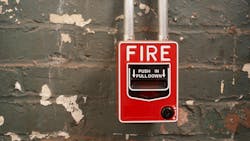Courtesy of www.MikeHolt.com.
All questions and answers are based on the 2023 NEC.
Q1: Fire alarm circuit cables and conductors installed exposed on the surface of ceilings and sidewalls shall be supported by _____, hangers, or similar fittings designed and installed so as not to damage the cable.
a) straps
b) staples
c) cable ties
d) any of these
Q2: Article _____ covers the general requirements for the installation of single- and multiple-conductor cables used in Class 2 and Class 3 power-limited circuits, power-limited fire alarm (PLFA) circuits, and Class 4 fault-managed power circuits, and optical fiber installations.
a) 722
b) 723
c) 724
d) 725
Q3: Enclosures for switches or overcurrent devices are allowed to have conductors feeding through where the wiring space at any cross-section is not filled to more than _____ of the cross-sectional area of the space.
a) 20%
b) 30%
c) 40%
d) 50%
Q4: For Class I locations where Sec. 501.140(A)(5) is applied, flexible cords shall be _____ from the power source to the temporary portable assembly and from the temporary portable assembly to the utilization equipment.
a) permitted to be spliced
b) of continuous length
c) installed in a metal raceway
d) spliced only using listed splicing kits
Q5: For FMC, _____ shall be installed where flexibility is necessary to minimize the transmission of vibration from equipment or to provide flexibility for equipment that requires movement after installation.
a) an equipment grounding conductor
b) an expansion fitting
c) flexible nonmetallic connectors
d) adjustable supports
Q6: The grounding electrode conductor connection shall be made at any accessible point from the load end of the overhead service conductors, _____ to the terminal or bus to which the grounded service conductor is connected at the service disconnecting means.
a) service drop
b) underground service conductors
c) service lateral
d) any of these
Answers:
Q1: d) any of these
According to Sec. 760.24(A), "Such cables shall be supported by hardware, including straps, staples, hangers, listed cable ties identified for securement and support, or similar fittings designed and installed so as not to damage the cable."
Q2: a) 722
Section 722.1 states, "This article covers the general requirements for the installation of single- and multiple-conductor cables used in Class 2 and Class 3 power-limited circuits, power-limited fire alarm (PLFA) circuits, and Class 4 fault-managed power circuits, and optical fiber installations."
Q3: c) 40%
Per Sec. 312.8(A)(1): "The total of all conductors installed at any cross-section of the wiring space does not exceed 40% of the cross-sectional area of that space."
Q4: b) of continuous length
Section 501.140(B)(5) requires flexible cords to be of continuous length where Sec. 501.140(A)(5) is applied.
Q5: a) an equipment grounding conductor
Per Sec. 348.60(B): "An equipment grounding conductor shall be installed where flexibility is necessary to minimize the transmission of vibration from equipment or to provide flexibility for equipment that requires movement after installation."
Q6: d) any of these
Section 250.24(A)(1) specifies, "The grounding electrode conductor connection shall be made at any accessible point from the load end of the overhead service conductors, service drops, underground service conductors, or service lateral to the terminal or bus to which the grounded service conductor is connected at the service disconnecting means."
These materials are provided by Mike Holt Enterprises in Leesburg, Fla. To view Code training materials offered by this company, visit www.mikeholt.com/code.
About the Author

Mike Holt
Mike Holt is the owner of Mike Holt Enterprises (www.MikeHolt.com), one of the largest electrical publishers in the United States. He earned a master's degree in the Business Administration Program (MBA) from the University of Miami. He earned his reputation as a National Electrical Code (NEC) expert by working his way up through the electrical trade. Formally a construction editor for two different trade publications, Mike started his career as an apprentice electrician and eventually became a master electrician, an electrical inspector, a contractor, and an educator. Mike has taught more than 1,000 classes on 30 different electrical-related subjects — ranging from alarm installations to exam preparation and voltage drop calculations. He continues to produce seminars, videos, books, and online training for the trade as well as contribute monthly Code content to EC&M magazine.
